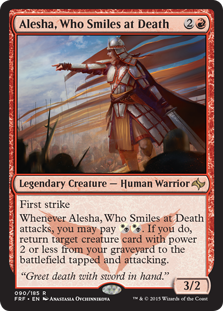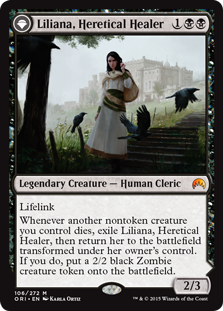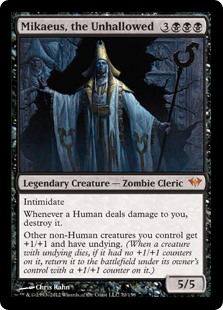Editor’s Note: We’re off today in celebration of the US holiday. Enjoy this Monday Magic article, which was originally published on January 16th.
Of all the articles created for this Monday Magic column, few articles have gotten as much attention (and took as much work to create) as the multi-part series on taking the long approach to building an EDH deck. The idea behind doing the series was twofold. First, it gave me the necessary excuse to build a new deck. Second, it provided the necessary platform for me to detail a different style of deck creation that is rarely written about – whittling a deck down from a large pool rather than from a tiny one.
Many players have the solid deckbuilding skills needed for tossing together a deck in a few hours by simply throwing together cards they have access to. Others prefer to use the trial by fire approach of putting cards into a deck and playing it extensively to see which cards work and which done, tuning it after every couple playthoughs.
In the case of folks like myself, however, due to a decent library of cards to choose from and constraints on how often it is I get to play – far less frequently than I used to – taking the refinement approach is challenging in getting a deck to function correctly right away. So I, like some, prefer to refine the deck via a more in depth (and time consuming) approach of developing it from a much larger collection of cards. This way is more work up front, true, but it also ensures that every card in the deck is made to serve a measured purpose for being there while also matching the gameplay style of the person it’s built for.
 To that end, I spent several weeks chronicling the creation of my version of a non-broken Alesha deck.
To that end, I spent several weeks chronicling the creation of my version of a non-broken Alesha deck.
You can catch up on the full process of that article series, entitled Assembling the Dragon Engine, through the following links:
- Part One – Ground Rules and Creature Compilation
- Part Two – Creature Breakdown
- Part Three – Refinement of Concept
- Part Four – Noncreature Permaments
- Part Five – Missed Inclusions
- Part Six – Utility Cards
- Part Seven – Major Culling
- Part Eight – The Final Cuts, Mana Fixing, and Final Thoughts
- Epilogue
For a post today, though, I thought it would be interesting to briefly revisit the final decklist that was made over the course of that series, clarify a couple card concerns that arose over the course of the series (as well as new ones since), and point out a few of the changes to it over the course of the last 13 months since its creation.
To start, this is what the final decklist was as of the series epilogue:
[spoiler show=”Click to see Alesha Who Smiles Back”]
Alesha' Who Smiles Back
Random Notes
– Overall, this version of an Alesha deck works particularly well for not being privy to an abundance of hyper-powerful combos. It has proven to be quite effective when it’s on point – which is generally more often than not. In fact, in many games it’s exceeded what I originally had planned for. Yet the deck is hardly unbeatable. This stability is reflected in the fact that very few cards have been changed since its creation.
– My experiment with using no mana rocks and instead focusing on land fetching for smoothing and acceleration purposes has largely proven successful. It’s not perfect, but I’ve generally found that so long as I have a staring hand of three land, the deck tends to do just fine.
– As I had feared in the series, the deck does seem to have a couple weak spots that may need to be addressed in the future. Namely, it has trouble with indestructible permanents and heavy graveyard hate. The former is more common than the latter, but one must always be wary of the lurking Bojuka Bog…
Card Observations
Thanks to the extensive development process the deck undertook, the vast majority of the cards in the deck behave as I expected them to. However, there have been a few exceptions:
Burnished Hart: Of all the cards in the deck, this one has surprised me the most in terms of its usefulness. I simply wasn’t expecting to be as effective as it has. It makes a great reanimation target, and using it to grab two lands each time massively thins out the basic land from the deck as the game progresses.The second most surprising would be Praetor’s Grasp. I knew it’d be handy in a pinch to use for mana acceleration if need be, but it’s also been handy at times to go after decks with a linchpin card, if only to remove it as an option.
 Liliana, Heretical Healer has proven surprisingly difficult to keep alive. She more than any other creatures in the deck besides Alesha seems to be a magnet for destruction. Probably something about planeswalkers…
Liliana, Heretical Healer has proven surprisingly difficult to keep alive. She more than any other creatures in the deck besides Alesha seems to be a magnet for destruction. Probably something about planeswalkers…
The ‘trick’ of using Mystic Barrier as a defensive maneuver while still throwing Alesha creatures has both intrigued and annoyed players with equal amounts. Mystic Barrier in general seems to frustrate some all by itself.
Wild Rocochet had nearly been on the cutting room floor numerous times during the build, but it has either saved me from dying or given me a win no less than five timess to date. Go go gadget copies!
Ch-ch-changes
While alterations to the deck have been impressively minor – that is the point of the long haul approach after all – Alesha has seen a handful of changes to date. These are:
–Ignition Team +Thief of Blood
I had hoped that Ignition Team would prove more impressive than it ultimately was. While I was occasionally able to generate a massive vanilla creature, and sneak in a kill with it now and then, it tended to get blocked more often than not. And when a 20/20 can be easily chump blocked, it loses some of its luster. Thief of Hope was mentioned as coming out right at the end of the articles, which made for an except swap. I had initially considered replacing Spike Cannibal for it, but although its overall more powerful, I like the 3 CMC for the Spike and the effect is good enough to be worth doubling. Plus, the Thief is another way of handling planeswalkers.
These two are practically interchangeable for me. Guiltfeeder initially lost out to Sewer Nemesis, but at one point I temporarily swapped out the Sewer Nemesis to test in a different deck and substituted Guildfeeder in the meantime. The Nemesis may very well end up back in the deck, but I definitely have come to really appreciate the powerful combination of Guildfeeder’s Fear evasion and life loss attack in this deck.
–Mikaeus, the Unhallowed +Gisela, Blade of Goldnight
 I was so dead-set on making Mikaeus have a home in this deck, especially in an unbroken manner. However, in his outings I’ve been sorely underwhelmed by its effect I’m sad to confess. The +1/+1 and undying buff is certainly helpful at times. Other times it’s proven useless. This is because roughly 1/3 of all creatures in the deck are actually human, including Alesha herself.
I was so dead-set on making Mikaeus have a home in this deck, especially in an unbroken manner. However, in his outings I’ve been sorely underwhelmed by its effect I’m sad to confess. The +1/+1 and undying buff is certainly helpful at times. Other times it’s proven useless. This is because roughly 1/3 of all creatures in the deck are actually human, including Alesha herself.
While I knew Mikey wouldn’t work with my Commander, it was unintentional that so many other creatures were also human. I ended up switching it out for a similarly powerful creature with Gisela. Somehow she had never even been considered in the original build, going to show that no matter how much preparation you do, you’re bound to always miss something. Her doubling attack power while reducing damage taken paints an equally big target for others to attack, but it also makes my creature attacks all the more useful.
–Herald of Leshrac +Gonti, Lord of Luxury
The Herald was always a bit of an experiment. Alas, it never quite worked the way I had hoped. The issue came down every time to it taking too long to build up counters to make it scary, and most people would just kill it by the time it became a nuisance. Every time it was resurrected the process starts anew, and even then you’d have to wait till your next turn before its effect can even go off. I had wanted to replace the Herald for a while, tentatively with Drana, Liberator of Malakir. But as I still don’t have a Drana to use, the latest substitution will see Gonti taken for a spin. The Praetor’s Grasp has already proven highly useful in this deck; being able to use a similar effect repeatedly should be even more fitting.
–Archetype of Courage +Recruiter of the Guard
I was almost reluctant to make this inclusion when the card originally came out, mostly for fear of power creep, but the card has proven to be incredibly useful without actually being overly problematic. The Recruiter found an easy home, as it can search for roughly half of the creatures in the deck, which is plenty for tutoring purposes. In exchange, I sadly had to say goodbye to the Archetype. In some ways, it was a holdout from an earlier deck iteration that contained more combat control than the final deck version. Having first strike on all of my creatures looked good on paper, but as many of my creatures without buffs are inherently small, first strike wasn’t incredibly scary in practice. Case in point: the Archetype itself rarely survived for long periods itself.
Cards of Concern
While I’ve been happy with the steady-handed nature of the deck since its creation, and that changes have been incremental, there are a number of other cards I’m keeping my eye on for efficiency’s sake:
Duergar Hedge-Mage: When it works, it works. Though it can be tricky sometimes having the necessary basic lands to get both effects. Spirit Bonds: Useful if I have the mana, but that’s not always the case in important moments. Sunforger: The buffing is very powerful, especially on Alesha, but it was always included for the spell tutoring. However, there’s only 8 cards it can grab, and I wonder if that’s too limiting sometimes. Mortify: This was chosen over Utter End because it was slightly cheaper as a response spell, but it’s also more restrictive in terms of which permanents it can hit. It also destroys versus exiles. With the creation of Anguished Unmaking, the question becomes if it’s still as viable with now two different alternatives to consider.
And that’s about it. After 13 months of playing and experimenting, this Alesha deck has proven reliable, consistent, and capable of putting up a decent fight even with multiple opponents. I’m quite happy with the process taken, and I look forward to using that process – albeit without a documented approach – with whatever my next Commander deck ends up being.
